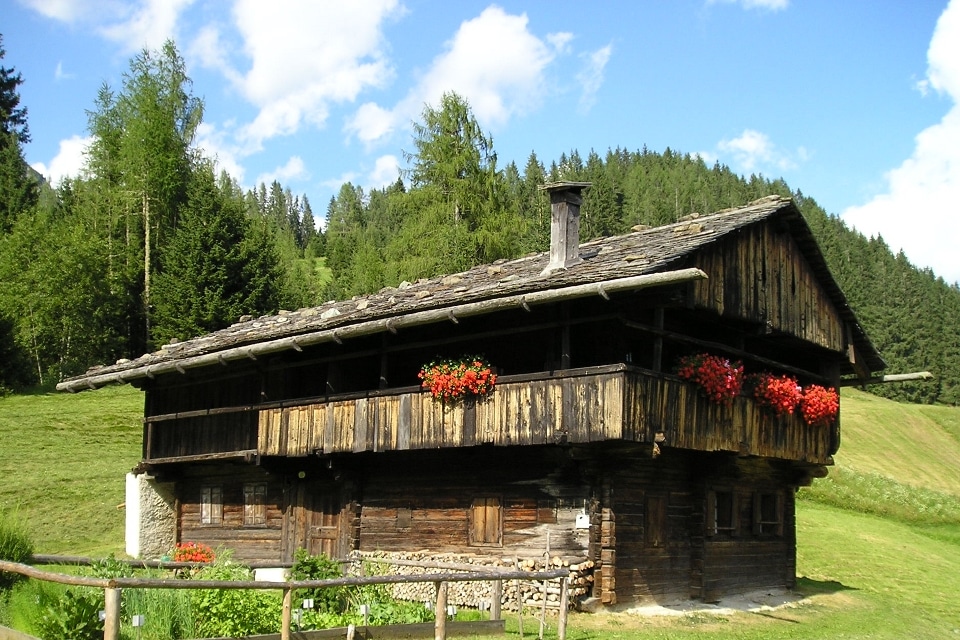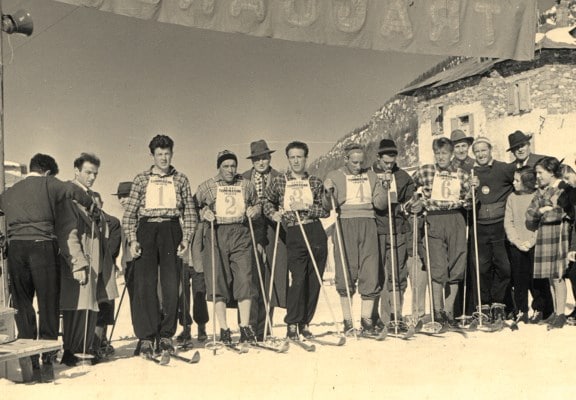Coat of arms of Sappada
Discover Sappada
We invite you to discover the beauty of our valley, our culture and our traditions.

Traditions & Hospitality
Sappada (Plodn in the German dialect of Sappada, Bladen in German) is a German-speaking language island between Austria, Veneto and Friuli Venezia Giulia at an altitude of 1,250 metres.
It extends longitudinally for about 5 km in a dolomitic valley in the province of Udine, near the sources of the Piave river. The country is divided into 15 boroughs (heivilan), whose names have been partly italianized or vice versa brought back to the German version.
Most of the commercial activities are located in the central avenue that crosses the villages of Bach, Granvilla and Palù, the so-called Sappada Centro. Sappada is a renowned tourist destination for its scenic beauty and sports facilities, both in summer and winter.
Guests can also learn about the history, its origins, the language (Sappada or plodarisch) which has been handed down only by the locals for more than 1000 years, the costumes, especially the carnival (Vosenòcht) with the figure of Rollate. Culture enthusiasts can visit the Giuseppe Fontana Ethnographic Museum, the House Museum of Rural Civilization and the Small Museum of the Great War. Noteworthy is the culture of cooking, based mainly on local products.
The boroughs of Sappada
A wonderful walk through the boroughs of Old Sappada, part of the »Most Beautiful Villages of Italy«: a plunge into the history and tradition of the valley, in each borough you discover peculiarities that make it unique.

Lerpa • Lerpa
Borgata Lerpa takes its name from the hydronym Lerch Poch, or Rio dei Larici, a stream that crosses it coming down from the southern slopes of the M. Ferro. It is the most recent of the boroughs of Sappada, having developed from the second decade of the 20th century at the western end of the village, where the chapel of St. John the Baptist (St. Mary Help of Christians since 1954) is since 1815.

Dorf • Granvilla
In the past it was the largest borough of Sappada, until 1928, when a fire destroyed the characteristic wooden houses from which it was formed. Only a few artefacts were saved, including the most conspicuous ancient masonry building in Sappada, Casa Solero Ortar (1642). In the village Granvilla you find the main church dedicated to Margherita Vergine e Martire, built on the foundations of an ancient Gothic church. On the bell tower you can still see the overlapping of the Renaissance and then Tyrolean style.

Moss • Palù
Its name comes from the Italian translation of the German word Moos, which indicates a marshy area. The great presence of clays in the area has been exploited in the past centuries for the manufacture of bricks. In ancient times there were buildings much older than the present one, unfortunately swept away by a landslide on Mount Morpa.

Pi(il)l • Pill
Borgata Pill, whose toponym refers to the relief on which it stands, i. e. the elevated position, dominating the western boroughs of the valley, on a hillock jutting out from the grassy slope in the guise of a small hill (Pill), is limited to a small conurbation situated a little further upstream of the route of the old road, between the altitudes of 1240 and 1263 m. Little affected by the 20th century urban development, this borough still retains its identity as a relatively isolated nucleus from the nearby boroughs Palù and Bach and offers a traditional architectural entity (18th and 19th centuries). The original family is, of course, the Piller family.

Poch • Bach
This borough is named after the creek “Bach “. The oldest buildings were destroyed by a fire in 1908 and rebuilt according to a grid plan. The small church of St. Anthony of Padua is the oldest building in the borough Bach and is characterized by a beautiful arched portal and stone jambs. The transfer, in 1953, of the seat of the town hall to the village of Bach, confirmed its role as the urban and civil centre of Sappada. And of course there is the Hotel Bladen in the borough Bach, your home for a dream stay.

Milpa • Mühlbach
The old mills and sawmills were located right along the river Mühlbach, hence the name of this ancient borough. Once there were various social activities here, such as a kindergarten, a tavern, a town hall, . . . all moved over time. In this borough you can see the only example of a three-storey wooden house. Starting from the valley there is a “Via Crucis”, dedicated to the Calvary of Christ. At the end of the way there is the chapel.
In the area there is also the “Little Museum of the Great War” and a large waterfall.

Kottrn • Cottern
Cottern is one of the smallest boroughs of Sappada. It seems to prolong in some way the nearby settlements of Mühlbach, while it appears clearly separated, to the East, to Hoffe, by a grassy belt that marks its detachment. A niche chapel, dedicated to the SS. Trinity and called Lexànd(e)rsmaindl, stands next to the road and testifies, with the partial burial, the lowest level of the original road.

Hóuve • Hoffe
Borgata Hoffe is one of the most interesting boroughs of Sappada, and one of the most representative for the completeness of its constituent elements and for the quantity and quality of the original architectural entities. It still retains a certain urban detachment from the neighboring boroughs Cottern and Fontana, characterized by grassy areas that allow you to appreciate its identity even today.

Prunn • Fontana
The name is due to the various water springs, rising upstream of the village and that once fed the numerous springs in the area. Three characteristic fountains are still visible today. Borgata Fontana offers one of the highest densities of architectural entities in the characteristic style of wooden architecture of Sappada.

Khrótn • Kratten
The borough of Kratten is a small cluster of houses, in a nice and sunny position on the slopes above the old road. Attached to the village, in addition to the splendid wooden houses, there is also a small church built in 1920 in honour of Our Lady of Lourdes.

Begar • Soravia
Soravia, separated to the west to Kratten borough by the riverbed of the same name. It is situated on the edge of a grassy cliff that overlooks it, projecting from the northern side of the valley. Different periods characterize the styles of the buildings, in a borough that houses an ancient church built in 1891 and dedicated to St. Joseph. The modern church, dedicated to the Queen of Peace, was built following a vow that the inhabitants made during the Second World War.

Ecke • Ecche
Ecche, whose toponym is based on a Sappada dialectal term (ecke, or canton, or hillock) referring to the morphology of the land. It is among all boroughs the one, that still retains the greatest urban detachment from the surrounding area. Its historical centre is distributed, in a very sunny position, on a bump on the profile of the northern side of the valley, just behind the vallecola dug by the Puiche river, at an average altitude of 1275 m, so it marks, compared to the previous boroughs, a significant rise.

Puicha • Puiche
Puiche, as well as being the most isolated, is the smallest borough of Sappada (barely 16 inhabitants – data of the year 2000). It appears almost mirror-like, as far as position is concerned, to the village of Ecche, on the edge of the opposite side of the Puiche river valley. The toponym of the village and of the river that laps it follows the term that in the local dialect designates the beech tree, with obvious reference to the vegetation of the woods above.

Krette • Cretta
Borgata Cretta, on the right side of Piave river, is in a position below the terraces of Cima Sappada at an average altitude of 1252 m, close to the cliff of the southern slopes of the Teston dei Larici, where the old road coincides with the main one. Among all the houses, Casa Puicher s’Kóttlarsch, is in an elevated position, dominating the borough. This house is a 19th century single-family house with almost unchanged characteristics, with the later incorporation of the barn-stable, recently subject to philological restoration and used as the “Museum of Peasant Civilization”.

Zepódn • Cima Sappada
Cima Sappada represents an urbanistic entity, historically perceived by the Sappada community as being particularly independent of any other borough. The etymology of Zepódn seems to allude to the location on the floor (zum pod(e)n) of the settlement, and is probably the origin of the Italian name of Sappada. The historical nucleus is concentrated at the northeastern end of the wide alluvial terrace that, at the corner of Val Sesis, dominates the valley of Sappada, at an average altitude of 1,297 m, and therefore marks a clear cut off from the other boroughs. There are reasons to believe that in this position the first settlement of the colonizing community took place in the Sappada basin, although this remains in the state of mere hypothesis.
Old times of Sappada




More detailed information about Sappada
Borgata Bach, 11
33012 Sappada (UD)
Tel: 0435 / 469 126
Borgata Bach, 11
c/o Municipio
33012 Sappada (UD)
Borgata Bach, 9
33012 Sappada (UD)
Tel.: 0435 / 469 131




